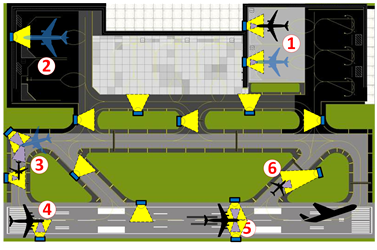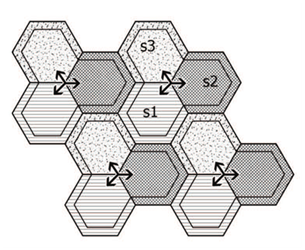Research
The future of networking relies on hybrid networks, and thus my research forcuses on the design and development of a wide range of hybrid wireless and optical networks, with emphasis on Optical Wireless Communication (OWC) technology, to provide low power connectivity for future networks and applications. My current research focuses on the design and development of wireless Data Center Networks (DCNs), and multicast optical switch architectures.

Configurable Optical Wireless Data Center Networks (funded by the US National Science Foundation - NSF, 2020-2022)
Most DCNs deployed today are wired. Despite recent advances, wired DCNs face cabling complexity, hotspot, and high energy consumption problems. To overcome these problems, recent research propagate the use of wireless communications to augment conventional wired DCNs and to develop pure wireless DCNs. In augmented wired DCNs, wireless links are used for inter-rack communication, whereas wired links are used for intra-rack links. In pure wireless DCNs, wireless links are used for both intra- and inter-rack communications.
In this project, we design an “OWC Bus” in which beams of OWC links are transmitted from servers on one side of the rack, aggregated then directed to the other side of the rack for distribution using splitters and mirrors. This idea is analogous to the legacy wired Bus network topology. This is an important step towards the development of pure optical wireless DCNs. We also propose a new class of cellular optical wireless DCNs, OWCell, in which racks are arranged in polygonal cells allowing racks to communicate easily using line-of-sight interrack links. A DCN topology is formed using a cluster of cells.
-
A.S. Hamza, Recent advances in the design of optical wireless data center networks, SPIE OPTO (PW19O), 2019. [Invited]

-
A.S. Hamza, S. Yadav, S.K. Samal, J.S. Deogun and D.R. Alexander, OWCell: Optical Wireless Cellular Data Center Network Architecture, IEEE International Conference on Communications (ICC), pp.2911-2916, 2017.

-
A.S. Hamza, J.S. Deogun and D.R. Alexander, Wireless Communication in Data Centers: A Survey, IEEE Communications Surveys & Tutorials, vol. 18, no. 3, pp.1572-1595, 2016.

-
A.S. Hamza, J.S. Deogun and D.R. Alexander, Evolution of Data Centers: A Critical Analysis of Standards and Challenges for FSO Links, 2015 IEEE Conference on Standards for Communications and Networking (CSCN), pp.100–105, Oct. 2015.

-
A.S. Hamza, J.S. Deogun and D.R. Alexander, Free Space Optical Data Center Architecture Design with Fully Connected Racks, 2014 IEEE Global Communications Conference (GLOBECOM), pp.2192,2197, 8-12 Dec. 2014.


Optical Wireless Communication (OWC) Technology & Applications
Optical Wireless Communication (OWC) technology, also known as Free space optics (FSO), has regained a great interest over the last decade as an attractive alternative or complementary technology for existing technologies, such as radio frequency (RF). Accordingly, FSO technology is being widely deployed in various indoor, terrestrial, space, and underwater systems.
We present a most-inclusive classification, CSOWC, that can be used to classify existing and future indoor, terrestrial, space, and underwater OWC links using common and simple unified notation. CSOWC can serve as a unified framework for researchers and standardization bodies to identify potential needed standards and to deliver efficient standards that meets the emerging market needs.
I am also interested in exploring new applications for OWC technology such as facilitating the Data Communications (Data Comm) capability of the NextGen framework, being developed by the Federal Aviation Administration (FAA), for airports surface operations. Moreover, an OWC link is confined to the room the system is installed, allowing low-complexity security measures and overhead, and thus power consumption.
OWC in Internet of Things (IoT)
Internet-of-Things (IoT) solutions require a large number of low-power devices being connected to the internet. Most existing wireless IoT solutions rely on radio frequency (RF) technologies for communication. The RF spectrum is becoming more congested and limited by interference. This motivated researchers to explore new technologies operating at different bands of the spectrum, one of which is the OWC technology. One of the subfields of OWC technologies is the Optical Camera Communication (OCC) in which a camera is used as a receiver to detect the modulated light. The bitrate of an OCC link depends on the frame rate of the receiving camera, and thus any low-cost OCC link will be limited in bitrate. A low bitrate OCC link can be useful for applications in which sensors periodically post lightweight data. The inexpensive and small in size, weight, and power OWC components make OWC a promising connectivity technology for the Internet of Things (IoT) applications.
-
T. Tripp, A.S. Hamza, B. Underwood, and Rahman Tashakkori, Low-Cost UFSOOK-Based Optical Camera Communication Link for IoT Applications, IEEE 6th World Forum on Internet of Things, 2020.

-
A.S. Hamza, J.S. Deogun and D.R. Alexander, Classification Framework for Free Space Optical Communication Links and Systems, IEEE Communications Surveys & Tutorials, vol. , no. , pp. 1-1, 2018.

-
A.S. Hamza, Optical Wireless Communications for Airport Surface Operations: Opportunities and Challenges, Integrated Communications, Navigation, and Surveillance (ICNS) Conference, pp.2B3-1-2B3-7, 2016.

-
A.S. Hamza, J.S. Deogun and D.R. Alexander, CSOWC: A Unified Classification Framework for Standardizing Optical Wireless Communications, IEEE Conference on Standards for Communications and Networking (CSCN), pp.112–117, Oct. 2015.


Multicast Optical Switches
In this project, we propose new classes of strictly and rearrangeably non-blocking multicast optical wireless switches to reduce the complexity of existing MEMS optical switches. The proposed classes are based on a switching element we denote as tri-state SE (T-SE). A T-SE can be realized using a liquid crystal material that can be configured in one of three states: reflective; transmissive; or splitting (half reflective/half transmissive). The proposed class of switches is optimal and cost effective with respect to hardware complexity.
-
A.S. Hamza, J.S. Deogun and D.R. Alexander, New Class of Rearrangeable Non-Blocking Multicast Free Space Optical Switches, IEEE/OSA Journal of Optical Communications and Networking (JOCN), vol.8, no.8, pp.569-581, 2016.

-
A.S. Hamza, J.S. Deogun and D.R. Alexander, Free Space Optical Multicast Crossbar, IEEE/OSA Journal of Optical Communications and Networking (JOCN), vol.8, no.1, pp.1-10, 2016.

-
A.S. Hamza, J.S. Deogun and D.R. Alexander, Rearrangeable Non-Blocking Multicast FSO Switch Using Fixed Switching Elements, 2015 IEEE Global Communications Conference (GLOBECOM), pp.1-6, 2015.

-
A.S. Hamza, J.S. Deogun and D.R. Alexander, Free Space Optical Multicast Crossbar Switch with Non-Movable Switching Elements, in Advanced Photonics for Communications, Optical Society of America, 2014, p.JT3A.13.


Resource Allocation in Cognitive Radio Networks (CRNs) [inactive]
In this project, we investigate the resource allocation problem in Cognitive Radio Networks (CRNs) using evolutionary algorithms, such as Genetic Algorithm (GA), Harmony Search (HS), and Particle Swarm Optimization (PSO) algorithms.
-
A.S. Hamza and J.S. Deogun, Low-Complexity Energy-Efficient Spectrum Allocation Algorithm for Cognitive Radio Networks, International Conference on Informatics and Systems (INFOS), pp.260-266, 2016.

-
A.S. Hamza, H.S. Hamza and M.M. El-Ghoneimy, Spectrum Allocation in Cognitive Radio Networks Using Evolutionary Algorithms, Chapter 10, H. Venkatarama and G.-M. Muntean (eds.), Cognitive Radio and its Application for Next Generation Cellular and Wireless Networks, Lecture Notes in Electrical Engineering 116, Springer Science+Business Media, Dordrecht, 2012.

-
H.M. Abdelsalam, H.S. Hamza, A.M. Al-Shaar and A.S. Hamza, On the Use of Particle Swarm Optimization Techniques for Channel Assignments in Cognitive Radio Networks, IGI Global, S. Ali, N. Abbadeni, M. Batouche, Edt., Multidisciplinary Computational Intelligence Techniques:Applications in Business, Engineering, and Medicine, 2012.

-
A.S. Hamza, On the Impact of Network Parameters on the Efficiency of Spectrum Allocation in Cognitive Radio Networks, International Conference on Information Technology: New Generations, pp.1074-1075, 2011.

-
A.S. Hamza, M. El-Ghoneimy, On the Effectiveness of using Genetic Algorithms for Spectrum Allocation in Cognitive Radio Networks, International Symposium on High Capacity Optical Networks Enabling Technologies, pp.183-189, 2010.


Inter-Cell Interference Coordination in LTE-A [inactive]
As part of the research project, 4G++ Project, that was funded by the National Telecommunication Regulatory Authority (NTRA) of Egypt, we surveyed the various Inter-Cell Interference Coordination (ICIC) schemes in the downlink of OFDMA-based cellular networks. We developed a new parameterized classification used to categorize and review various static (frequency reuse-based) and dynamic (cell coordination-based) ICIC schemes.
-
A.S. Hamza, S.S. Khalifa, H.S. Hamza and K. Elsayed, A Survey on Inter-Cell Interference Coordination Techniques in OFDMA-Based Cellular Networks, IEEE Communications Surveys & Tutorials, vol.15, no. 4, pp.1642-1670, 2013.
